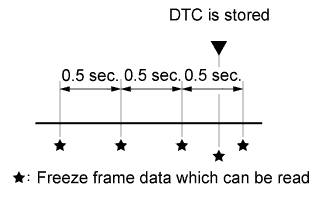Automatic Transmission System (For 1Gr-Fe) Diagnosis System
Drivetrain. Hilux. Tgn26, 36 Kun25, 26, 35, 36 Ggn25
EURO-OBD
M-OBD (EXCEPT EUROPEAN SPECIFICATION)
NORMAL MODE AND CHECK MODE
2-TRIP DETECTION LOGIC
FREEZE FRAME DATA
CHECK DATA LINK CONNECTOR 3 (DLC3)
CHECK BATTERY VOLTAGE
CHECK MIL
Automatic Transmission System (For 1Gr-Fe) -- Diagnosis System |
When troubleshooting Europe On-Board Diagnostic (Euro-OBD) vehicles, the vehicle must be connected to an OBD scan tool (complying with ISO 15765-4). Various data output from the vehicle ECM can then be read.
Euro-OBD regulations require that the vehicle on-board computer illuminate the Malfunction Indicator Lamp (MIL) on the instrument panel when the computer detects a malfunction in any of the following:
- The emission control system/components
- The powertrain control components which affect vehicle emissions
- The computer
In addition, the applicable Diagnostic Trouble Codes (DTCs) prescribed by ISO 15765-4 are stored in the ECM memory.
If the malfunction does not recur in 3 consecutive trips, the MIL goes off automatically but the DTCs remain stored in the ECM memory.
To check DTCs, connect the intelligent tester or OBD scan tool to the Data Link Connector 3 (DLC3) of the vehicle. The scan tool displays DTCs, freeze frame data and a variety of engine data.
The DTCs and freeze frame data can be cleared with the scan tool (HILUX_TGN26 RM000000W770UMX.html).
| M-OBD (EXCEPT EUROPEAN SPECIFICATION) |
When troubleshooting Multiplex On-Board Diagnostic (M-OBD) vehicles, the vehicle must be connected to the intelligent tester. Various data output from the ECM can then be read.
OBD regulations require that the vehicle on-board computer illuminate the MIL on the instrument panel when the computer detects a malfunction in any of the following:
- The emission control system/components
- The powertrain control components which affect vehicle emissions
- The computer
In addition, the applicable Diagnostic Trouble Codes (DTCs) prescribed by ISO 15765-4 are stored in the ECM memory.
If the malfunction does not recur in 3 consecutive trips, the MIL goes off automatically but the DTCs remain stored in the ECM memory.
| NORMAL MODE AND CHECK MODE |
The diagnosis system operates in normal mode during normal vehicle use. In normal mode, 2-trip detection logic is used to ensure accurate detection of malfunctions. Check mode is also available to technicians as an option. In check mode, 1-trip detection logic is used to increase the ability of the system to detect malfunctions, including intermittent malfunctions, when reproducing malfunction symptoms (intelligent tester only).
When a malfunction is first detected, the malfunction is temporarily stored in the ECM memory (1st trip). If the ignition switch is turned off and then turned to ON again, and the same malfunction is detected again, the MIL illuminates.
The ECM records vehicle and driving condition information as freeze frame data the moment a DTC is stored. When troubleshooting, freeze frame data can be helpful in determining whether the vehicle was moving or stationary, whether the engine was warmed up or not, whether the air-fuel ratio was lean or rich, as well as other data recorded at the time of a malfunction.
The intelligent tester displays freeze frame data recorded at five different points: 1) 3 times before the DTC is stored, 2) once when the DTC is stored, and 3) once after the DTC is stored. The data can be used to reproduce the vehicle condition from around the time of the malfunction. The data may be helpful in determining the cause of a malfunction. It may also be helpful in determining whether a DTC is being caused by a temporary malfunction.
If the voltage is below 11 V, replace the battery before proceeding.
- Standard voltage:
- 11 to 14 V
Check that the MIL illuminates when the ignition switch is turned to ON.
If the MIL does not illuminate, there is a problem in the MIL circuit (HILUX_TGN26 RM000000WZ10Z4X.html).
When the engine is started, the MIL goes off.


